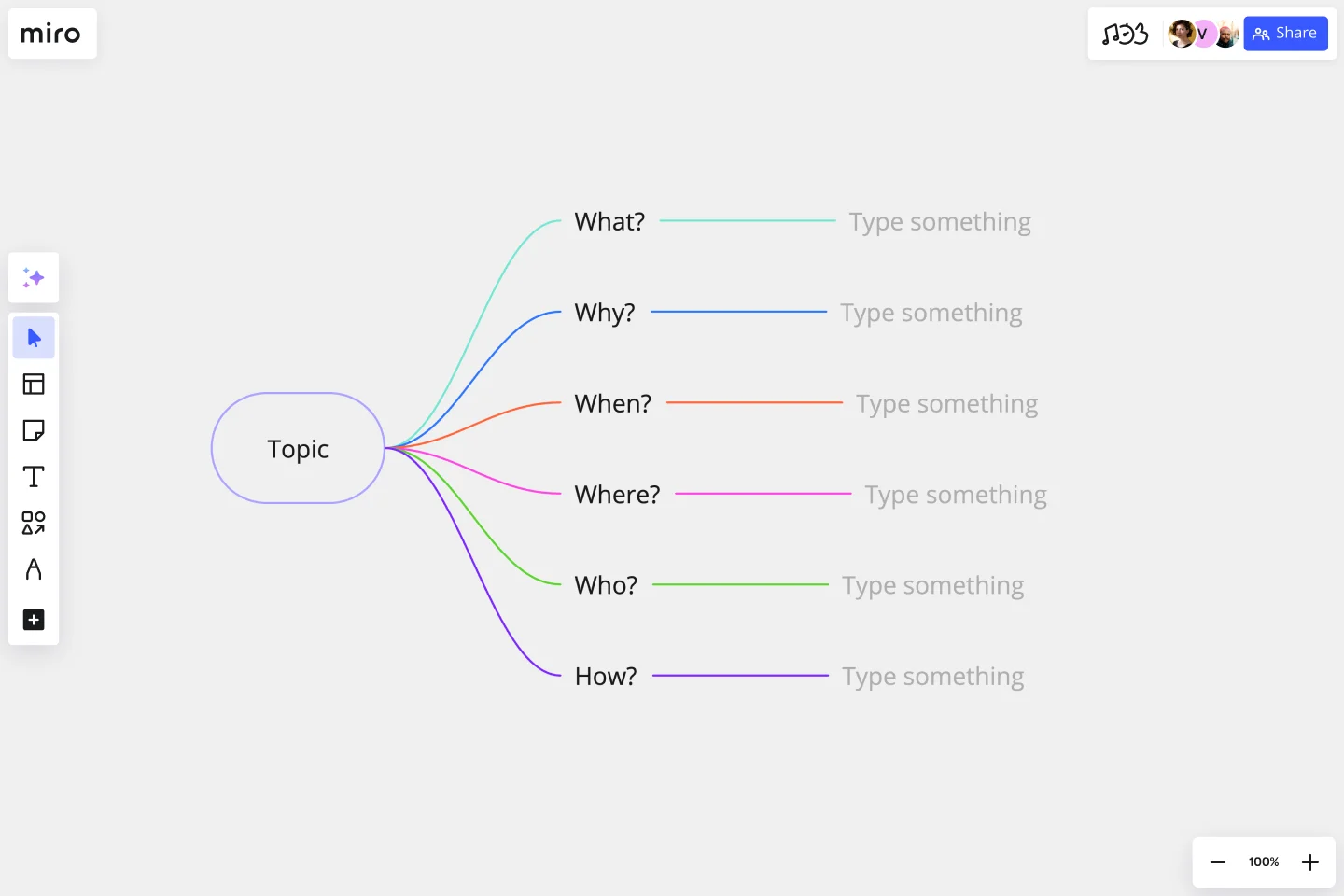5W1H Template
Use the 5W1H Template to promote structured thinking. By methodically addressing these core questions, teams can eliminate oversights and ambiguities, leading to more informed decisions and a clearer path to achieving their objectives.
About the 5W1H Template
The 5W1H Template is a dynamic tool at the intersection of collaboration and structured thinking. Universally recognized, this method offers clarity and direction to any project or challenge. By systematically addressing each of the core questions, teams can streamline their approach, ensuring alignment and understanding from inception to completion.
What's a 5W1H Template?
The 5W1H Template stands for "What, Who, Where, When, How, and Why." It's a foundational framework used for problem-solving, planning, and decision-making. By answering these six fundamental questions, teams can gain a holistic understanding of a situation, project, or problem, ensuring thoroughness and clarity in their approach.
One significant benefit of using the 5W1H Template is that it promotes structured thinking, preventing oversight and ensuring that every aspect of a situation or challenge is considered. This comprehensive view minimizes misunderstandings, mitigates risks, and facilitates effective communication among team members, stakeholders, or any involved parties.
How to use the 5W1H Template: A quick guide
Begin with 'Who': Start by identifying the key stakeholders, team members, or parties involved. This step ensures everyone pertinent to the situation or project is considered from the outset.
Define the 'Where': It's crucial to set the context here. Depending on your project, this could be a physical location, a digital platform, or a conceptual space.
Specify 'When ': Indicate the time, be it a specific date, a timeframe, or a recurring schedule. If there's a deadline, this is the place to note it.
Detail the 'How': Describe the methods, tools, or processes that will be implemented. This is where the mechanics of the project or solution are elucidated.
Clarify the 'Why': This might be the most crucial step. Addressing the 'Why' means delving into the motivation, purpose, or reasoning behind the action or situation. It's the driving force that often determines the success of a project.
Use Miro's automated diagramming features: As you flesh out your analysis, you might find the need to expand sections or delve deeper into specific points. Miro's automated diagramming capabilities allow you to extend the template easily, accommodating additional content or complex relationships.
Collaborate in real time or async: One of the strengths of using Miro is the capability to collaborate seamlessly. Invite team members to your board, allowing them to contribute in real time for immediate feedback or asynchronously to accommodate different schedules and time zones.
By systematically addressing each component of the 5W1H framework, you ensure a holistic understanding of your project or problem and foster effective team collaboration and communication. Whether working synchronously or asynchronously, the combined clarity of the 5W1H approach and the versatility of Miro's features set your team up for success.
Can I customize the 5W1H Template in Miro?
Yes, Miro's templates are designed to be flexible. You can change sections, colors, and layouts to fit your team's specific needs.
How can I share my 5W1H analysis with non-Miro users?
Miro offers various export options. You can share your board as a PDF, image, or even grant view-only access to those without a Miro account.
Is there a limit to how many people can collaborate on a 5W1H board?
With Miro's premium plans, there's no limit to how many team members you can invite. Everyone can collaborate and contribute in real time.
Can I integrate the 5W1H Template with other tools?
Yes, Miro integrates seamlessly with popular tools such as Slack, Trello, and Asana, making incorporating your 5W1H analysis into your broader project management strategy easier.
Get started with this template right now.
Weekly Planner by Elina Schäfer
Weekly Planner template is perfect for organizing your weekly tasks and schedules. It helps you prioritize activities, set deadlines, and manage your time effectively, ensuring you stay productive and on track throughout the week.
Timeline Workflow by Reza Zolf
Works best for:
Planning, Strategy
The Timeline Workflow template helps streamline your project workflows. It’s perfect for visualizing processes, identifying bottlenecks, and optimizing tasks. This template enhances team collaboration and ensures smooth project execution.
Resource Management Gantt Chart
Works best for:
Strategy, Planning
Efficient resource allocation is crucial for project success. The Resource Management Gantt Chart template helps you plan and manage your resources effectively. Use it to track the availability and allocation of personnel, equipment, and materials throughout your project. This template ensures resources are optimally utilized, reducing waste and avoiding delays, providing a clear overview of assignments and workload balance.
Business Pitch Template
Works best for:
Business Pitch
The Business Pitch Template uses visual aids to enhance your pitch, making it more impactful and easier to understand. This gives your pitch an edge, leaving a lasting impression and greatly improving your ability to convey your ideas persuasively.
Target Audience Template
Works best for:
Marketing, Desk Research, Prioritization
Understanding your target audience is vital to business success. How can you market yourself effectively if you don’t know who you’re targeting? Using the Target Audience template, you can review valuable data about who your customers are and what they want from your product or service.
Product / Market Fit Canvas Template
Works best for:
Market Research, Strategic Planning, Product Management
The product/market fit canvas template is used to help product teams meet customer and market needs with their product design. This template looks at a product in two dimensions: first, how the product fits user needs, and second, how the fully designed product fits within the market landscape. This combined metric understands a product holistically from the way customers use and desire a product, to the market demand. By comparing customer and product qualities side by side, users should better understand their product space and key metrics.
